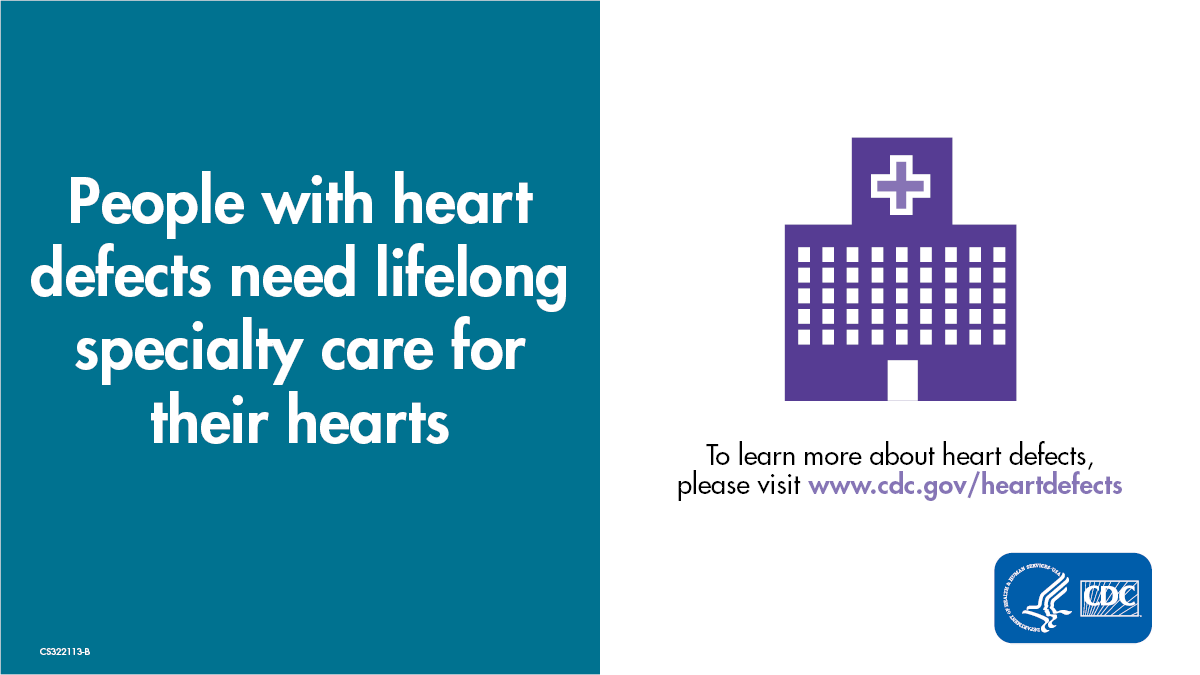At a glance
- Congenital heart defects are present at birth and can affect the heart's structure and the way it works.
- Heart defects are common, costly, and critical conditions that affect people throughout their lives.

Heart defects are common
Heart defects are the most common type of birth defect. In the United States, about 40,000 babies are born with a heart defect each year.

Heart defects can be diagnosed during or after pregnancy
Some heart defects can be found during pregnancy by looking at ultrasound pictures of the heart of the developing baby. Other heart defects aren’t detected until birth through newborn screening, or later in life, during childhood or adulthood. Screening newborns for heart defects enables them to be treated early and may prevent other health problems or early death.

Heart defects are costly
In the United States, hospital costs can exceed $9.8 billion a year to care for people living with heart defects. Families of children with heart problems who have special healthcare needs may experience high out-of-pocket medical expenses. These families may also experience impacts on employment and other financial problems. Costs involved in living with a heart defect are often unpredictable. Planning for these expenses as early as possible can help your family stay financially healthy. Ask your healthcare provider for information about any financial assistance programs in your state.

People with heart defects are living longer
As medical care and treatment have advanced, people with heart defects are living longer and healthier lives. Overall, there are slightly more adults living with heart defects than children. As survival rates have increased, researchers are continuing to look at health issues and needs across the lifespan. This will help ensure people born with heart defects are getting needed care at every stage of life.

People with heart defects need lifelong specialty care
Even with improved treatments, many people with a heart defect are not cured, even if their heart defect has been repaired. People with a heart defect can develop other health problems over time. Depending on their specific heart defect, the number of heart defects they have, and the severity of their heart defect. Ongoing appropriate medical care for their heart defect will help children and adults live as healthy a life as possible.

- Hoffman JL, Kaplan S. The incidence of congenital heart disease. J Am Coll Cardiol. 2002;39(12):1890-1900.
- Reller MD, Strickland MJ, Riehle-Colarusso T, Mahle WT, Correa A. Prevalence of congenital heart defects in Atlanta, 1998-2005. J Pediatr. 2008;153:807-13.
- Swanson J, Ailes EC, Cragan JD, et al. Inpatient Hospitalization Costs Associated with Birth Defects Among Persons Aged <65 Years — United States, 2019. MMWR Morb Mortal Wkly Rep 2023;72:739–745.
- Gilboa SM, Devine OJ, Kucik JE, Oster ME, Riehle-Colarusso T, Nembhard WN, Xu P, Correa A, Jenkins K, Marelli AJ. Congenital heart defects in the United States: estimating the magnitude of the affected population in 2010. Circulation. 2016 12;134(2):101-9.
- Mahle B, et al. (2009). Role of Pulse Oximetry in Examining Newborns for Congenital Heart Disease. A Scientific Statement From the American Heart Association and American Academy of Pediatrics. Circulation. 2009;120(5):447-58.
- Holland BJ, Myers JA, Woods CR, Jr. Prenatal diagnosis of critical congenital heart disease reduces risk of death from cardiovascular compromise prior to planned neonatal cardiac surgery: a meta-analysis. Ultrasound in obstetrics & gynecology. 2015;45(6), 631–638.
- 2018 AHA/ACC Guideline for the Management of Adults With Congenital Heart Disease. Journal of the American College of Cardiology. 2019;73(12):e81-e192.
